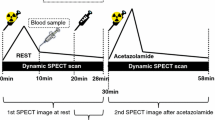Abstract.
We have constructed a three-dimensional stereotaxic ROI template (3DSRT) on anatomically standardised cerebral blood flow (CBF) single-photon emission tomography (SPET) images to objectively estimate regional CBF (rCBF). The 3DSRT is composed of 259 regions of interest (ROIs) in 11 segments (1, superior frontal; 2, middle and inferior frontal; 3, primary sensorimotor; 4, parietal; 5, angular; 6, temporal; 7, occipital; 8, pericallosal; 9, lenticular nucleus; 10, thalamus; 11, hippocampus) on each side. We measured the rCBF values of the 518 ROIs and calculated the area-weighted average (segmental CBF; sCBF) of the 22 segments based on the rCBF in each ROI. We compared vascular reserve before and after revascularisation surgery using sCBF on anatomically standardised resting and acetazolamide (Acz)-challenged CBF SPET images, which were obtained using an equal-volume-split dual-injection single-day protocol [resting and vascular reserve (RVR) method] in 13 patients who had not suffered any major stroke but did have significant cerebrovascular stenosis. Prior to the evaluation, we examined the sCBF values of 16 subjects with various cerebrovascular conditions (8, normal; 3, lacunar infarction; 2, chronic infarction; 2, meningioma; 1, aneurysm) using physiological saline instead of Acz (placebo study) in order to confirm the reproducibility of the RVR method. In the placebo study we observed excellent linearity (y=1.444+0.964x) between the 352 pairs of baseline (x) and post-placebo (y) sCBF values in the 16 subjects, irrespective of the segment location. In all of the 13 patients, estimation of sCBF demonstrated impaired vascular reserve pre-operatively and improved vascular reserve postoperatively. We conclude that the 3DSRT, which could be identically set on the anatomically standardised images obtained at baseline and after Acz injection, allowed objective assessment of the pre- and postoperative vascular reserve, which was not easy with conventional ROI settings. While 3DSRT appeared useful for the evaluation of regional vascular reserve as well as rCBF, further study is necessary to clarify its general clinical value.
Similar content being viewed by others
Author information
Authors and Affiliations
Additional information
Received 20 June and in revised form 31 October 2001
Electronic Publication
Rights and permissions
About this article
Cite this article
Takeuchi, R., Yonekura, Y., Matsuda, H. et al. Usefulness of a three-dimensional stereotaxic ROI template on anatomically standardised 99mTc-ECD SPET. Eur J Nucl Med 29, 331–341 (2002). https://doi.org/10.1007/s00259-001-0715-z
Published:
Issue Date:
DOI: https://doi.org/10.1007/s00259-001-0715-z




